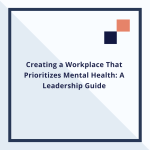In today’s fast-paced and high-pressure work environments, mental health has become a critical concern for both employees and employers. The importance of well-being in the workplace cannot be overstated, as mental health issues can significantly impact productivity, engagement, and overall job satisfaction. Forward-thinking leaders are recognizing that fostering a healthy workplace environment is not just a moral responsibility but also a strategic business decision.
In this article, we explore how leaders can create a supportive, mentally healthy work environment and why it matters for long-term organizational success.
Table of contents [Show]
- 1. Lead by Example: Promoting a Culture of Mental Health Awareness
- 2. Implement Flexible Work Arrangements
- 3. Create a Safe Space for Open Communication
- 4. Provide Mental Health Resources and Support
- 5. Promote a Healthy Work Environment
- 6. Recognize and Reward Efforts
- 7. Provide Leadership Training on Mental Health
- Conclusion
1. Lead by Example: Promoting a Culture of Mental Health Awareness
One of the most effective ways to foster a workplace environment that values mental health is for leaders to model the behavior they want to see. Leaders who prioritize their own mental health and openly discuss the importance of well-being set a powerful example for their teams.
Key steps leaders can take:
- Normalize mental health discussions: By talking openly about mental health, leaders can help break the stigma surrounding the topic. Whether it’s sharing personal experiences or discussing the importance of self-care, leaders can make it easier for employees to seek help when they need it.
- Prioritize work-life balance: Leaders should encourage a healthy work-life balance by setting boundaries for themselves and their teams. For instance, avoiding after-hours emails or encouraging employees to take time off when needed sends a clear message that well-being is valued.
2. Implement Flexible Work Arrangements
Flexibility in the workplace has a profound impact on employee mental health. Giving employees the freedom to manage their schedules and work remotely or in hybrid models can reduce stress and improve overall well-being.
How leaders can promote flexibility:
- Offer remote work options: Whether full-time or part-time, allowing employees to work from home can help reduce commute-related stress, provide a more comfortable environment, and enable better work-life balance.
- Provide flexible hours: Not everyone’s productivity peaks during the traditional 9-to-5 workday. Giving employees the flexibility to adjust their work hours to better fit their personal lives can significantly reduce burnout and increase job satisfaction.
3. Create a Safe Space for Open Communication
One of the biggest barriers to mental health support in the workplace is the fear of judgment or retaliation. Employees need to feel that they can openly communicate their mental health challenges without fear of negative consequences.
Strategies to create an open communication environment:
- Establish confidential support channels: Offer confidential outlets, such as an Employee Assistance Program (EAP), where employees can seek mental health support without disclosing their struggles to their direct supervisors.
- Foster a non-judgmental atmosphere: Leaders should create a culture of trust and support where employees feel comfortable discussing their mental health. This can be done through regular check-ins, one-on-one meetings, and open-door policies that prioritize listening.
4. Provide Mental Health Resources and Support
To truly prioritize mental health in the workplace, leaders need to ensure that employees have access to the resources they need to maintain and improve their mental well-being.
Effective ways to provide support include:
- Offer mental health benefits: Providing comprehensive mental health benefits, such as counseling services, therapy sessions, or access to mental health apps, can make a significant difference in employees’ lives.
- Host mental health workshops: Organize workshops or webinars led by mental health professionals that focus on stress management, mindfulness, resilience, and coping strategies.
- Create mental health days: Encourage employees to take mental health days when needed, recognizing that mental well-being is just as important as physical health.
5. Promote a Healthy Work Environment
The physical and emotional atmosphere in the workplace plays a major role in influencing employees' mental health. Leaders should strive to create a positive, supportive, and inclusive environment that encourages well-being.
Ways to cultivate a healthy work environment:
- Encourage social connections: Promote teamwork and social interaction among employees through team-building activities, virtual coffee breaks, or informal gatherings. Building strong relationships at work helps employees feel more connected and supported.
- Reduce workplace stress: Identify and address sources of stress within the organization, whether it’s excessive workloads, unrealistic deadlines, or poor communication. By alleviating unnecessary stressors, leaders can create a more balanced and harmonious work environment.
6. Recognize and Reward Efforts
Recognition and appreciation are crucial for mental well-being. When employees feel that their hard work is acknowledged and valued, they are more likely to feel motivated and engaged.
How leaders can recognize and reward their teams:
- Celebrate achievements: Regularly recognize employees’ accomplishments, both big and small. Public recognition, whether in team meetings or through company-wide communications, can boost morale and reduce stress.
- Offer tangible rewards: Go beyond verbal praise by offering tangible rewards such as bonuses, additional time off, or wellness-related gifts. This shows employees that their efforts are valued and appreciated.
7. Provide Leadership Training on Mental Health
Leaders play a critical role in shaping workplace culture, but they may not always have the tools or knowledge to support mental health effectively. Providing leadership training that focuses on mental health awareness and management can equip managers with the skills to better support their teams.
Topics to include in leadership training:
- Mental health first aid: Teach leaders how to recognize the signs of mental health challenges and how to respond appropriately.
- Stress management techniques: Equip leaders with strategies for managing their own stress and preventing burnout in their teams.
- Creating inclusive environments: Train leaders on the importance of inclusivity and how to foster a culture of support for all employees, regardless of their mental health status.
Conclusion
Prioritizing mental health in the workplace is no longer optional—it's a necessity for leaders who want to create resilient, productive, and engaged teams. By promoting open communication, offering mental health resources, and fostering a supportive work environment, leaders can play a pivotal role in improving the well-being of their employees.
As businesses continue to evolve, those that prioritize mental health will not only see the benefits in employee happiness and retention but also in the long-term success of the organization. Leadership that puts people first is the key to a thriving, sustainable future.






